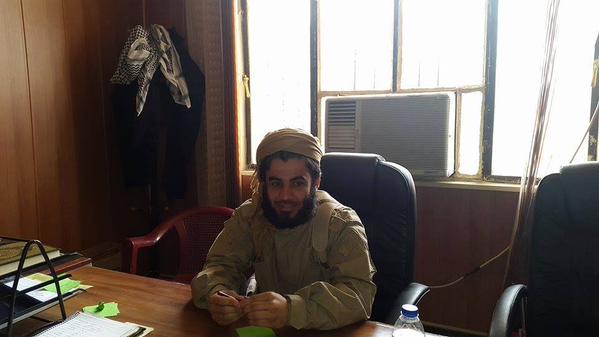
Islamic State Develops New Strategies to Destabilize the KRG
Publication: Terrorism Monitor Volume: 13 Issue: 6
By:

In recent months, the Islamic State militant group has started using ethnic Kurdish militants in operations against the security forces of the Kurdistan Regional Government (KRG) in Iraq and in its propaganda materials. Some Kurdish Islamic State militants have taken part in videoed killings. For instance, on January 26, Kurdish Islamist State militant Mofaq Asa’ad Askander was filmed beheading a captured Kurdish Peshmerga soldier in Mosul, shocking Iraqi Kurds (MEMRI, January 26). The presence of such Kurds in the Islamic State raises important questions: Could the Islamic State use these Kurds to conduct attacks inside the usually safe Kurdistan region, or to target Western troops presently training the Kurdish Peshmerga forces in the KRG capital Erbil? Despite a few attacks, the answer appears to be no.
Local and Diaspora Recruits
According to Hemin Hawrami, a senior official in the Kurdistan Democratic Party (KDP), around 300 to 350 young Iraqi Kurds have so far joined the Islamic State. [1] Other sources estimate around 500 joined the Islamic State in 2014 (Rudaw, February 27). Some recruits are students of former radical members from the Islamist movement in the Kurdistan region that developed in the 1980s while others had been involved in more recent militant groups. For instance, Mofaq Askander and his two brothers, Younis and Musa, were former Mosul-based operatives of al-Qaeda in Iraq and joined the Islamic State when it took the city in June (Rudaw, February 5). Another source of recruits are ethnic Kurds who became radicalized in the West, such as the 18-year-old ethnic Iraqi Kurd Muhammad Hadi, from the UK, who travelled to join the Islamic State in early 2014 (Daily Mail, June 29, 2014). The Islamic State appears to be using more Iraqi Kurds in their propaganda, as opposed to Kurds from Iran, Syria or Turkey.
Militant Operations
Thus far, there have been a few significant attacks inside Kurdistan attributed to the Islamic State. On August 23, 2014, a bomb attached to a car wounded four people on the Erbil-Kirkuk road (Rudaw, August 23, 2014). The year before, on September 29, 2013, there was an attack against the Security Directorate in Erbil (KRG.org, September 30, 2013). However, it is surprising that with a more than 1,000 kilometer frontline between Kurdistan and Arab-areas of Iraq, the Islamic State has not carried out more attacks in the KRG, using Kurdish radicals who can move with relative ease across the border. Nevertheless, there is the continuing potential for the Islamic State to use its Kurdish recruits’ knowledge of the local terrain and cultural-social knowledge in conducting suicide operations within Kurdistan. The Islamic State has also used Kurds in more conventional military operations on the fringes of Kurdish regions in Syria and Iraq, including in the Syrian town of Kobane (Ayn al-Arab in Arabic), where Kurdish Islamic State fighters were even led by a Kurdish commander known as Abu Khattab al-Kurdi, as well as in the Mosul area and Kirkuk (Vice, November 7, 2014).
One reason for the Islamic State’s lack of attacks in the KRG is the work of the Kurdish security service, the Asayish. Despite the huge influx of displaced persons and the Asayish themselves fighting on the frontlines, there has not been an appreciable security vacuum for the Islamic State to exploit. Moreover, the Asayish has stepped up their monitoring of potential militants, and has arrested several Islamic State-supporters and sleeper cells. For instance, in January, the Asayish arrested six pro-Islamic State clerics in several locations, and has reportedly even deported some Kurdish families, who are from north of Erbil, after their two sons joined the Islamic State (Rudaw, February 27; Duhok Post, February 16). However, it is unclear how many suspected Islamic State militants and supporters have been arrested in total in Kurdistan.
Moreover, the local awareness of Kurdish citizens to this potential threat has increased. It is difficult today for Kurdish radicals to even express sympathy with the Islamic State, since most locals would immediately report such suspicious behavior to the Asayish. Indeed, before the August attacks, there were some Kurds expressing sympathy for the Islamic State publicly. Now this seems to be impossible, and many conservative Islamists in Kurdistan have tried to distance themselves from the Islamic State since its expansion last year. Other radicals have preemptively left the region; one pro-Islamic State Kurdish preacher, Mullah Shwan al-Kurdi, reportedly joined the group in November, possibly fearing arrest by the Asayish (Rudaw, November 27).
Social Media Propaganda
Aside from direct military attacks, however, the Islamic State has in recent months also increased its use of Kurds in media propaganda operations aimed against the Kurdistan region. For instance, the group has published footage of the radical Kurdish preacher, Mullah Shwan al-Kurdi, taking part in operations against the Peshmerga on the outskirts of Kirkuk on January 31, in which he promised that the group would capture Erbil (Bas News, January 31). Al-Kurdi was also featured in an Islamic State propaganda video released in February showing captured Kurdish Peshmerga fighters dressed in orange jumpsuits in a cage. [2]
The Islamic State also appears to have increased their social media messages in Kurdish in order to spread fear among the Kurdish population and to counter Kurdish media criticism of the group. These messages have also tried to show that the Islamic State is not against Kurdish Muslims, only secular Kurdish parties. For instance, one Islamic State statement published in January said that the Peshmerga are not fighting on behalf of religion, and that they have ties to Israel, United States and Iran: “They want to create Kurdistan as an independent state, with the help of the Jewish state and spread of democracy… They openly say that they don’t believe that state and religion should be united.” [3] This online recruitment effort by the Islamic State was one reason why the KRG temporarily shut down Twitter and Facebook access in the region in August 2014 (Middle East Eye, August 10, 2014).
PSYOPs vs Kurdish Clerics
In response, the KRG has used religious leaders to counter Islamic State propaganda, and help to discourage potential recruits (War is Boring, February 9). In response, the Islamic State has threatened Muslim Kurdish leaders with death for declaring that slain Peshmerga are “martyrs.” However, according to a Kurdish senior advisor Abdulsalam Medeni, the Islamic State’s propaganda has found some resonance locally: “Some mullahs in the mosques during the Friday prayers send this message directly or indirectly… The grassroots Muslims think our government is not respecting Islamic traditions.” [4] Likewise, in March, in the Kurdish town of Bardarash, two Kurds were arrested for vandalizing a Peshmerga grave, writing on it “no God but Allah” (Bas News, March 12).
Nevertheless, the number of Kurds joining the Islamic State has decreased since the militant group attacked the Kurdistan region (Rudaw, February 27). While many Kurdish Islamists sympathized with the struggle against Syrian President Bashar al-Assad in 2011 (which they viewed as a war between al-Assad and Muslims), they generally do not sympathize with the internal fights between jihadist groups, or with jihadist attacks on Kurds in Syria and Iraq. In addition, the allure of the Islamic State has diminished as the group has been increasingly pushed onto the defensive in 2015.
Conclusion
The impact of the Islamic State’s several hundred Kurdish members has, so far, been less than might be expected. The group has not been able to use these Kurds to take over Kurdish dominated areas, or to wage regular attacks inside Kurdistan. Indeed, with Western support, the Kurdish government has managed to maintain internal security, and security conditions have improved overall in Kurdistan since the Kurds managed to take back most Kurdish areas in Iraq from the Islamic State after August 2014. Meanwhile, the number of Kurdish recruits to the Islamic State has decreased due to effective Asayish actions, the security awareness of local citizens and because of the jihadist movement’s decreasing popularity among Islamist Kurds. In addition, the Kurdish government has effectively responded to the Islamic State’s propaganda attacks on its secular government. Despite this, however, a considerable number of Kurds remain active with the Islamic State in areas controlled by the group, and a limited risk of attacks by Kurdish radicals will therefore remain for the foreseeable future.
Wladimir van Wilgenburg is a political analyst specializing in issues concerning Iraq, Iran, Syria and Turkey with a particular focus on Kurdish politics.
Notes
1. Hemin Hawrami speech, “Kurdistan in Transition–Political reconfiguration in Rojava (Syrian Kurdistan) and South Kurdistan (Iraqi Kurdistan) in the wake of IS military setbacks,” Utrecht University, February 28, 2015.
2. Islamic State, “Healing the heart of the believers,” February 21, 2015, https://archive.org/details/ISIS.peshmerga.kirkuk.
3 Aseer Sunni al-Kurdi, “Peshmerga, a group full of hatred and unbelief,” January 3, 2015, https://justpaste.it/iqdx.
4. Author interview with Abdulsalam Medeni, a senior advisor to the Deputy Prime Minister of the Kurdistan region, March 13, 2015.





